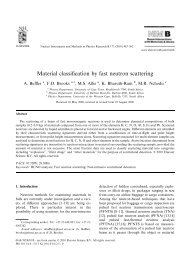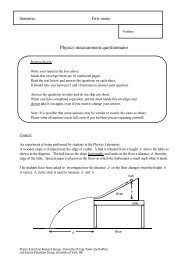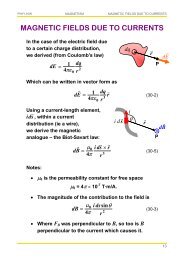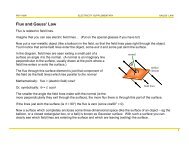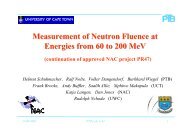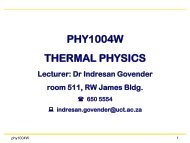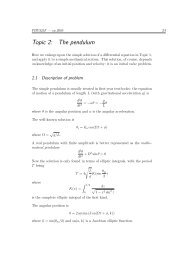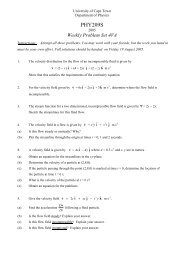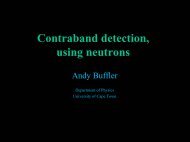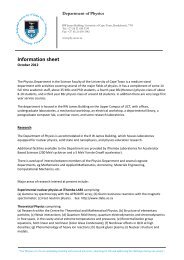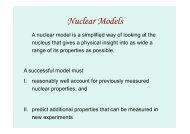ideas about measurement in terms of point and set paradigms
ideas about measurement in terms of point and set paradigms
ideas about measurement in terms of point and set paradigms
Create successful ePaper yourself
Turn your PDF publications into a flip-book with our unique Google optimized e-Paper software.
10 A. BUFFLER ET AL.<br />
plotted po<strong>in</strong>ts were classified accord<strong>in</strong>g to the <strong>set</strong> paradigm. S<strong>in</strong>ce least squares<br />
fitt<strong>in</strong>g is not <strong>in</strong>troduced at school, responses associated with the <strong>set</strong> paradigm<br />
before <strong>in</strong>struction were exemplified by:<br />
The l<strong>in</strong>e should have more or less equal numbers <strong>of</strong> dots (represent<strong>in</strong>g <strong>measurement</strong>s)<br />
above <strong>and</strong> below it, because <strong>in</strong> that case we get best average value.<br />
(SLG response)<br />
I have tried to make the l<strong>in</strong>e lie so that all po<strong>in</strong>ts lie at a m<strong>in</strong>imum distance from the<br />
l<strong>in</strong>e.<br />
(SLG response)<br />
After <strong>in</strong>struction, students could expla<strong>in</strong> their <strong>set</strong> action accord<strong>in</strong>g to the procedure<br />
<strong>of</strong> least squares fitt<strong>in</strong>g, for example:<br />
I just took the path that is <strong>in</strong> between all po<strong>in</strong>ts plotted. Not to pass through them all,<br />
but to decrease the space between all po<strong>in</strong>ts <strong>and</strong> the l<strong>in</strong>e.<br />
(SLG response)<br />
I have drawn a l<strong>in</strong>e which approximates a least squares fit to the data. The distance<br />
between the l<strong>in</strong>e <strong>and</strong> each po<strong>in</strong>t has been m<strong>in</strong>imized (approximately).<br />
(SLG response)<br />
Table 2 displays the frequencies <strong>of</strong> student responses for the UR <strong>and</strong> SLG probes<br />
classified accord<strong>in</strong>g to the po<strong>in</strong>t <strong>and</strong> <strong>set</strong> <strong>paradigms</strong> before <strong>in</strong>struction aga<strong>in</strong>st<br />
responses by the same students after the laboratory course. Table 2 shows that<br />
43% <strong>of</strong> the students used the <strong>set</strong> paradigm consistently after <strong>in</strong>struction, while a<br />
similar percentage were <strong>in</strong>consistent <strong>in</strong> their use <strong>of</strong> the two <strong>paradigms</strong>. The proportion<br />
<strong>of</strong> consistent po<strong>in</strong>t data processors decreased after <strong>in</strong>struction from 77% to<br />
13%, while the proportion <strong>of</strong> consistent <strong>set</strong> data processors has <strong>in</strong>creased from 7%<br />
to 43%. However, caution needs to be exercised before assert<strong>in</strong>g that these students<br />
may be categorized as consistently us<strong>in</strong>g the <strong>set</strong> paradigm, s<strong>in</strong>ce it is possible that<br />
the formalistic procedures <strong>of</strong> f<strong>in</strong>d<strong>in</strong>g the mean <strong>and</strong> fitt<strong>in</strong>g a straight l<strong>in</strong>e may have<br />
been used by rote. It is necessary to <strong>in</strong>clude the analysis <strong>of</strong> the probes deal<strong>in</strong>g with<br />
the comparison <strong>of</strong> data <strong>set</strong>s <strong>in</strong> order to assess the consistency <strong>of</strong> the <strong>paradigms</strong> used<br />
by the students.<br />
Table 2.<br />
Students’ use <strong>of</strong> <strong>paradigms</strong> when process<strong>in</strong>g data <strong>set</strong>s (UR <strong>and</strong><br />
SLG probes).<br />
Paradigm after <strong>in</strong>struction<br />
Consistent po<strong>in</strong>t Mixed Consistent <strong>set</strong><br />
paradigm paradigm paradigm Total<br />
Paradigm Consistent po<strong>in</strong>t 9 26 19 54<br />
before paradigm (13%) (37%) (27%) (77%)<br />
<strong>in</strong>struction Mixed 0 5 6 11<br />
<strong>paradigms</strong> (0%) (7%) (9%) (16%)<br />
Consistent <strong>set</strong> 0 0 5 5<br />
<strong>paradigms</strong> (0%) (0%) (7%) (7%)<br />
Total 9 31 30 70<br />
(13%) (44%) (43%) (100%)



